Tracking the experience
Editor's note: John Chisholm is CEO of CustomerSat, Inc., a Mountain View, Calif., research firm.
Scientists tell us that the human brain has thousands as many times inputs as outputs. Optic and auditory nerves and the spinal cord are among the high-bandwidth inputs; speech and motor control are among the relatively few low-bandwidth outputs. Few would dispute the effectiveness of the resulting human design.
Similarly, highly effective enterprises have many more inputs than outputs. All individuals and organizations that touch or are touched by an enterprise - customers, prospects, suppliers, employees, shareholders, partners (in our parlance, all "customers") - have knowledge that can benefit enterprises. Some of this valuable knowledge is reflected in, or can be inferred from, customer purchases and support transactions. But the vast majority of it - future intentions, perceptions, competitive knowledge, willingness to recommend, satisfaction and other attitudes - cannot. Enterprises that systematically gather and channel these "inputs" to the employees who can act on them enjoy advantages in competitiveness and profitability.
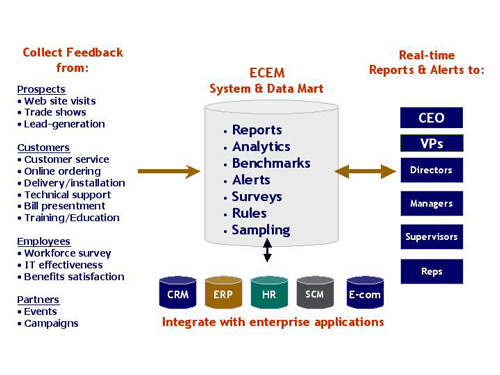 |
Enterprise sensory nervous system
Enterprise customer experience management (ECEM) systems serve enterprises in the same way that optic, auditory, and other nerves serve the brain. ECEM systems enable enterprises to fully tap the knowledge of customers, in real-time, so employees can act on it immediately (Figure 1). ECEM systems gather feedback from every key point of contact between enterprises and their customers - from call centers to Web sites to bill presentment to trade shows - and deliver that feedback in forms actionable by potentially any and every employee in the enterprise. Rating scores, tables, trend lines, statistics, suggestions, complaints, and praise are presented graphically and can be analyzed by product, region, sales or service rep, or any other way desired, enabling employees to pinpoint concerns, opportunities, and responsive action (Figure 2). ECEM systems deliver feedback intelligently, without swamping employees with irrelevant data or barraging customers with unreasonable requests.
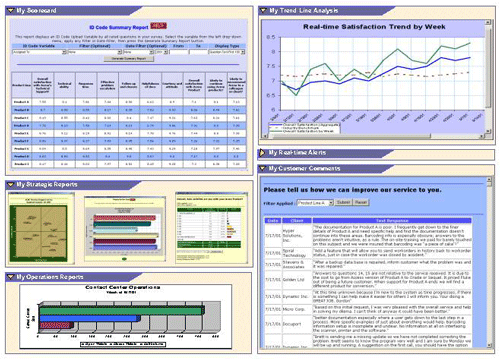 |
In our experience with designing and implementing online ECEM systems, we have discovered that the effectiveness and productivity of every employee, from CEO to service rep, can be enhanced by the right stream of real-time customer feedback. Regional sales directors use feedback from customers in their regions to make staffing and resource decisions. Product line managers use feedback from users of their products to prioritize new features and plan marketing campaigns. Customer service reps are empowered to improve their skills and work habits by responding to feedback from customers they have served. Web operations uses feedback to enhance Web site effectiveness; manufacturing uses feedback to enhance product reliability. ECEM "data marts" - central repositories of customer feedback easily accessible to authorized users throughout the enterprise - enable managers at all levels to monitor and manage performance in real-time. ECEM real-time alerts drive workflow and enable immediate responses to customer concerns and opportunities. ECEM systems provide a better, common understanding of the external world throughout the enterprise, helping align objectives and priorities of people across all departments, divisions, and business units.
ECEM ROI in e-commerce
Ariba, a Sunnyvale, Calif., enterprise spend management solutions provider, has experienced a 100 percent return on its ECEM investment. Multiple factors contribute to this strong ROI (Figure 3). The largest contributor is increased revenue resulting from enhanced customer retention and advocacy. ECEM enables Ariba employees to address customer concerns and opportunities immediately. Very often, customers are more satisfied and loyal if concerns are dealt with swiftly - thus demonstrating a supplier's responsiveness - than if concerns never arise in the first place. Keeping just one customer from defecting to a competitor, or winning one new customer through word-of-mouth, will often more than pay for an ECEM solution.
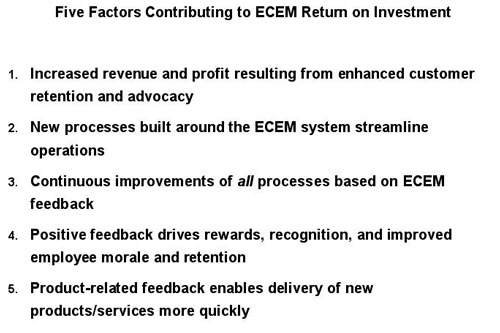 |
Other factors contribute to strong ECEM returns as well. Ariba put new processes in place around its ECEM system that streamlined operations. For example, technical support reps now provide immediate follow-up on real-time alerts, thus avoiding less efficient responses. Ariba has also continuously improved all of its processes based on ECEM feedback. For example, support reps now use a customer-preferred contact method for communications, speeding problem resolution time. By making positive feedback very visible, ECEM has improved employee morale and retention. Ariba managers proactively disseminate positive feedback and use it to drive rewards and recognition. Finally, product-related feedback has enabled Ariba to deliver new products/services more quickly. As a result of these and other actions, overall satisfaction improved by a full half-point in six months. "Online customer feedback helps us retain valued customers and build life-long relationships," says Keith Krach, chairman of the board of Ariba.
ECEM extends CRM at McKesson
ECEM systems integrate with and complement enterprise applications, in particular customer relationship management (CRM) systems (Figure 4). While CRM systems track behavior (which customers purchased how much of what and visited which areas of a Web site), ECEM systems track attitudes and intentions (e.g., satisfaction, future purchase intentions, likelihood to recommend). As a result, ECEM show why particular results occurred that were reported by CRM.
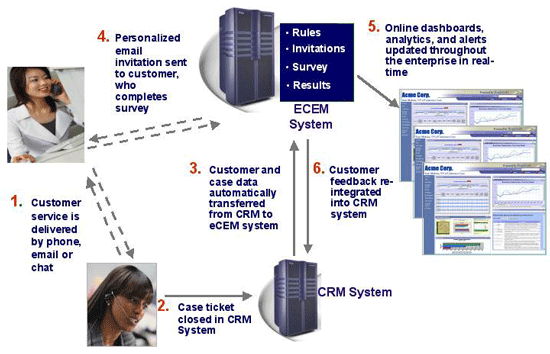 |
For example, CRM systems may indicate that financial services customers in the northeast region bought 10 percent less of product X last week than they did in an earlier week. ECEM systems can indicate that that drop in sales was due to dissatisfaction with reliability of product X; a lack of technical skills in the representative that serves those customers; the introduction of a superior product from a competitor in that region; or a combination of the above factors.
By integrating with a CRM system, an ECEM solution, be it internal or outsourced, becomes an integral part of an enterprise's information network. At McKesson Information Solutions, Alpharetta, Ga., for example, ECEM extends its PeopleSoft CRM system. Each night, the PeopleSoft system sends to ECEM a data file containing records of customer cases closed the previous day. ECEM first applies business rules to determine which customers will be asked for feedback. Typically, only customers who have not previously been surveyed in the last 45 days will be asked, to avoid over-surveying customers. ECEM then generates a personalized e-mail invitation to each customer requesting feedback through an online survey. The questionnaire seen by the customer is completely tailored to the customer and case, based on information provided by the CRM system. Because of the personalization and ease with which customers respond, McKesson enjoys response rates of nearly 60 percent to the survey.
As soon as the customer completes the survey, online reports and analytics are updated for, and alerts e-mailed to, the appropriate employees throughout the enterprise in real-time. Authorized employees can use information from the CRM system - for example, case type, severity, sales region, customer size or type, product type, service rep, day of week, or time of day - to analyze data to pinpoint responsive action. Later, selected customer feedback can be sent from the ECEM to the CRM system to become part of the customer record, if desired. Such 360-degree integration enables a support rep contacting a customer to be particularly sensitive to satisfaction drivers, such as technical skills, promptness, or courtesy, with which the customer may not have been fully satisfied on the last interaction.
ECEM systems also integrate with e-commerce Web sites to enable all departments that support e-commerce - such as Web operations, online marketing, product management, online fulfillment, and business development - to act immediately on real-time feedback from online customers and prospects. Web site visitors can be surveyed as soon as they complete a transaction or, as in the case of Humana, Inc., a Louisville, Ky., health services company, as they exit a site from any page (Figure 5). Smart ECEM questionnaires reflect customers' purchase histories or sections of the site visited.
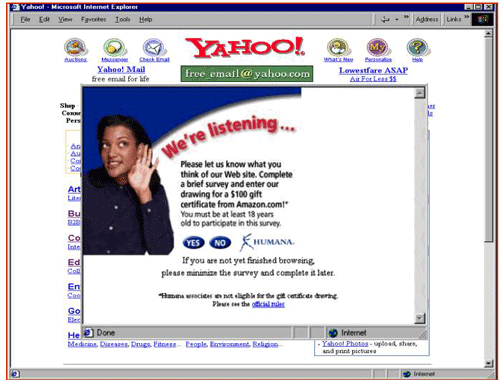 |
Global ECEM at Nortel
ECEM systems integrate with all enterprise databases, not just CRM. Integrating with supply chain management systems provides real-time feedback from suppliers; with HR systems, from employees; and with enterprise resource planning systems, from internal customers of finance and operations.
Toronto-based communications firm Nortel Networks uses a comprehensive ECEM solution to gather detailed feedback on Nortel products and services from 4,000 key customers worldwide. Fifty-four different fields describing customers and their purchases are transferred from various Nortel enterprise databases to their ECEM system, allowing high degrees of personalization of invitations and questionnaires (including language) and precision in pinpointing issues and follow-on actions. The system is highly visible, as customer feedback drives incentive compensation for executives and managers throughout Nortel.
"Our ECEM system enables us to very quickly deploy a complex feedback program to our worldwide customer base in 15 different languages, ranging from French and Spanish, to different Chinese dialects," says Richard Jung, vice president, marketing, Nortel Networks. "We continually access and review the ongoing stream of customer data through ECEM's online reporting, so we can proactively address our customers' needs and drive improved satisfaction and retention."
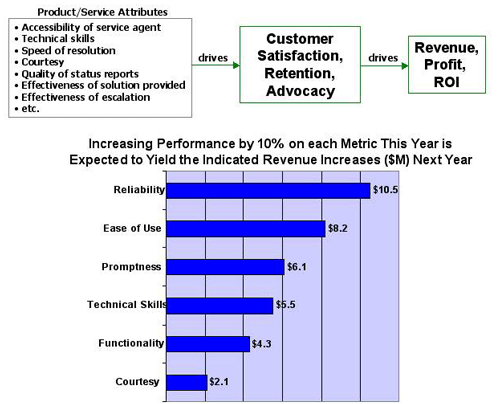 |
Predicting the future
After gathering feedback for only a few months, ECEM solutions become strategic data repositories that can help firms prioritize investments and predict their effect on the bottom line. Enterprise modeling uses ECEM data to determine the impacts on business goals, such as revenue and profitability, of changes in performance metrics such as product reliability, ease of use, service promptness and technical skills (Figure 6). These models let managers predict, for example:
- ROI by customer, product, channel, region, department, supplier, or employee;
- areas in which to invest or de-invest to increase revenues and ROI;
- expected financial impacts of improvements in performance.
Enterprise modeling with ECEM can show, for example, that "improving satisfaction with technical skills by 10 percent this year can be expected to yield an additional $5.5 million in revenues next year." Such models help ensure that enterprises apply capital and people most effectively. They also help executives justify and attract internal funding for operations, service, and support.
Like the human sensory nervous system, ECEM systems enable enterprises to keep in touch with the outside world. ECEM systems are truly the eyes, ears, and fingertips of healthy, growing enterprises.
